When she was at the top, Jean Arthur stunned columnists by recoiling from interviews, by showing an aversion to publicity and by avoiding parties and nightclubs. She was even compared to Greta Garbo for her alleged elusiveness. In 1942, she received a Sour Apple Award for being the least cooperative actress in Hollywood. About the capital of cinema, she was adamant: "I hated the place - not the work, but the lack of privacy, those terrible, prying fan magazine writers and all the surrounding exploitation". In private, she was known to be shy and insecure and to be plagued with stage and screen fright. She also sought perfection in her work, always fearing not attaining the high standards of acting she had set for herself. In real life, she always took great care to retain her privacy, her individuality and her non-conformism and she could appear as anti-social to many people. She once said: "I’m not an adult, that’s my explanation of myself. Except when I’m working on a set, I have all the inhibitions and shyness of the bashful, backward child". She also declared: "As a character in a play, I feel as if I can be what people expect. As Jean Arthur, I never feel as if I know what people expect". For sure, she was a complex and conflicted person ... but what a good actress she became!
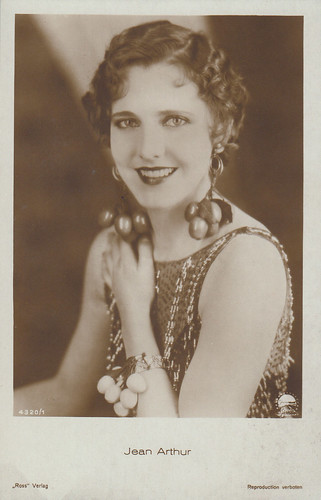
German postcard by Ross Verlag, no. 4320/1, 1929-1930. Photo: Paramount.

Spanish postcard by M.C., Barcelona, no. 90.

Spanish postcard by M.C., Barcelona, no. 233.

French postcard by Europe, no. 641. Photo: Paramount.
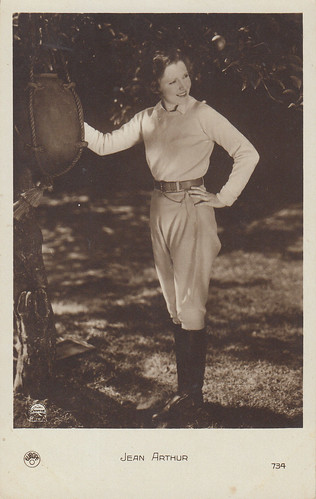
French postcard by Europe, no. 734. Photo: Paramount.
A long struggle to achieve recognition
Jean Arthur was born Gladys Georgianna Greene on the 17th of October 1900 in Plattsburgh, New York, U.S.A. Her father was a photographer. During the First World War, she took a job as a stenographer but later turned to photographic modelling. This led her to be noticed by Fox and she made her film debut in a supporting role in John Ford’s Cameo Kirby (1923). She took her stage name from Saint Joan of Arc / Jeanne d’Arc, who was one of her favourite heroines, and King Arthur. She was then given a leading part in The Temple of Venus (1923) but was found too inexperienced and was quickly replaced by Mary Philbin.
For a few years, she was mostly seen in comedy shorts and low-budget Westerns. In 1928, she got her break in the Paramount film Warming Up, which earned her good reviews. As a result, she was given a three-year contract. Unfortunately, during her stay at Paramount, she appeared mostly in inconsequential ingenue roles. Nevertheless, from time to time, she had the opportunity to impress the critics, for example in The Mysterious Dr Fu Manchu (1929) or as Clara Bow’s conniving little sister in The Saturday Night Kid (1929).
At the time, she had an affair with David O’Selznick, who was then a rising young Paramount executive. He tried his best to promote her but it seemed that the company had somewhat lost interest in her and was not really convinced anymore that she would ever make it to the top.
In 1931, her contract was not renewed and Jean Arthur decided to go on stage. Interestingly enough, her plays brought her on the whole more recognition than she ever had during her movie days.
After her personal success on Broadway in 'The Curtain Rises' (1933), an offer came from Columbia to play a reporter opposite Jack Holt in Whirlpool (1934). During filming, Columbia executives felt she had the makings of a star and decided to sign her to a five-year contract in February 1934. They put her in The Defense Rests (1934) and The Most Precious Thing in Life (1934) with mixed results but she soon shone as a hard-boiled working girl in John Ford’s The Whole Town’s Talking (1935).
After her personal success on Broadway in 'The Curtain Rises' (1933), an offer came from Columbia to play a reporter opposite Jack Holt in Whirlpool (1934). During filming, Columbia executives felt she had the makings of a star and decided to sign her to a five-year contract in February 1934. They put her in The Defense Rests (1934) and The Most Precious Thing in Life (1934) with mixed results but she soon shone as a hard-boiled working girl in John Ford’s The Whole Town’s Talking (1935).
Definitely gone was the nondescript ingenue of a few years before: a new image of Jean Arthur had emerged. Her career moved forward with such films as Party Wire (1935) or If You Could Only Cook (1935). After Carole Lombard had backed out, she was chosen by Frank Capra to play Babe Bennett, a cynical newspaperwoman who finally falls in love with the man she had been cheated on, in Mr Deeds Goes to Town (1936), opposite Gary Cooper. It finally made her a full-fledged star.
She then notably was William Powell’s co-star in The Ex-Mrs Bradford (1936) and, as Calamity Jane, reunited with Gary Cooper in Cecil B. De Mille’s The Plainsman (1937). She also showed her skills in films such as History Is Made at Night (1937) and Easy Living (1937).

German postcard by Ross Verlag, no. A 2941/1, 1939-1940. Photo: Paramount.

German postcard by Ross Verlag, no. A 1474/1, 1937-1938. Photo: Paramount.
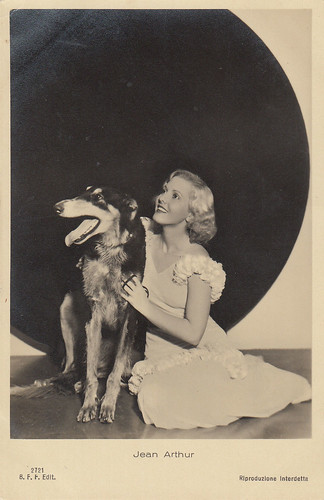
Italian postcard by Ballerini & Fratini, Firenze, no. 2721.

German postcard by Ross Verlag, no. A 1198/1, 1937-1938. Photo: Paramount.

Italian postcard by Ballerini & Fratini, Firenze, no. 2883.
In March 1938, she signed a new contract with Columbia, succeeding in adding a clause which relieved her from any duty to participate in interviews or public appearances. In December 1938, she screen-tested for the role of Scarlett O’Hara in Gone With the Wind but most people agreed that she was not suited for the part.
She was again successfully directed by Frank Capra in You Can’t Take It with You (1938) and Mr Smith Goes to Washington (1939). Furthermore, she tremendously liked being directed by George Stevens in The Talk of the Town (1942) and The More the Merrier (1943), which got her her only Oscar nomination. She also joined the list of 'Hawksian Women' in Howard Hawks’ Only Angels Have Wings (1939).
Her other films include The Devil and Miss Jones (1941) and The Lady Takes a Chance (1943), which were produced by her then-husband Frank Ross for RKO. After The Impatient Years (1944), her contract with Columbia was over, much to her relief. Their relationship had been a stormy one and she had been suspended on several occasions.
In 1947, she signed a three-picture deal with Paramount. She only made two: Billy Wilder’s A Foreign Affair (1948) and George Stevens’ Western Shane (1953). She gave good performances in both but the ever-insecure actress thought Wilder had favoured Marlene Dietrich in the first and was not too fond of the latter as she "couldn’t use any comedy bits in it at all and just had to act old and worn out".
After she repeatedly turned down the scripts offered to her, Paramount bought out the rest of her contract and she never made another Hollywood movie. In the mid-1960s, she decided to give television a try and starred in 1965 in an episode of the popular series Gunsmoke. She was delighted by the results and was then featured in 1966 in a weekly 30-minute situation comedy program called The Jean Arthur Show, in which she played a lawyer. Unfortunately, it was a flop and was cancelled after twelve episodes. In August 1973, to the amazement of everyone, in view of her bashfulness, she agreed to appear, alongside Frank Capra, in the only talk show of her career, The Merv Griffin Show.
She then notably was William Powell’s co-star in The Ex-Mrs Bradford (1936) and, as Calamity Jane, reunited with Gary Cooper in Cecil B. De Mille’s The Plainsman (1937). She also showed her skills in films such as History Is Made at Night (1937) and Easy Living (1937).

German postcard by Ross Verlag, no. A 2941/1, 1939-1940. Photo: Paramount.

German postcard by Ross Verlag, no. A 1474/1, 1937-1938. Photo: Paramount.

Italian postcard by Ballerini & Fratini, Firenze, no. 2721.

German postcard by Ross Verlag, no. A 1198/1, 1937-1938. Photo: Paramount.

Italian postcard by Ballerini & Fratini, Firenze, no. 2883.
At the top of her profession
In March 1938, she signed a new contract with Columbia, succeeding in adding a clause which relieved her from any duty to participate in interviews or public appearances. In December 1938, she screen-tested for the role of Scarlett O’Hara in Gone With the Wind but most people agreed that she was not suited for the part.
She was again successfully directed by Frank Capra in You Can’t Take It with You (1938) and Mr Smith Goes to Washington (1939). Furthermore, she tremendously liked being directed by George Stevens in The Talk of the Town (1942) and The More the Merrier (1943), which got her her only Oscar nomination. She also joined the list of 'Hawksian Women' in Howard Hawks’ Only Angels Have Wings (1939).
Her other films include The Devil and Miss Jones (1941) and The Lady Takes a Chance (1943), which were produced by her then-husband Frank Ross for RKO. After The Impatient Years (1944), her contract with Columbia was over, much to her relief. Their relationship had been a stormy one and she had been suspended on several occasions.
In 1947, she signed a three-picture deal with Paramount. She only made two: Billy Wilder’s A Foreign Affair (1948) and George Stevens’ Western Shane (1953). She gave good performances in both but the ever-insecure actress thought Wilder had favoured Marlene Dietrich in the first and was not too fond of the latter as she "couldn’t use any comedy bits in it at all and just had to act old and worn out".
After she repeatedly turned down the scripts offered to her, Paramount bought out the rest of her contract and she never made another Hollywood movie. In the mid-1960s, she decided to give television a try and starred in 1965 in an episode of the popular series Gunsmoke. She was delighted by the results and was then featured in 1966 in a weekly 30-minute situation comedy program called The Jean Arthur Show, in which she played a lawyer. Unfortunately, it was a flop and was cancelled after twelve episodes. In August 1973, to the amazement of everyone, in view of her bashfulness, she agreed to appear, alongside Frank Capra, in the only talk show of her career, The Merv Griffin Show.
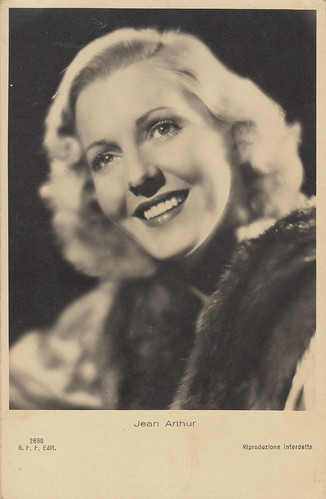
Italian postcard by Ballerini & Fratini, Firenze, no. 2690.

British postcard by Picturegoer, no. 438b. Photo: Columbia.
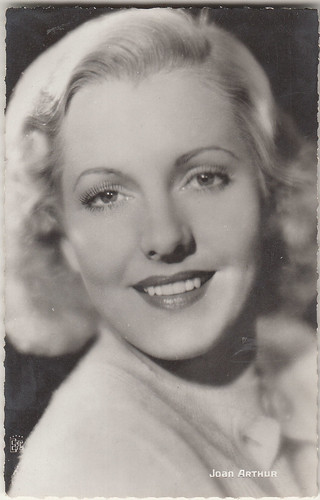
French postcard by Editions et publications cinématographiques (EPC), no. 164.

British postcard. Photo: Columbia. Jean Arthur in The Whole Town’s Talking (John Ford, 1935). Passport to Fame was the British premiere title.

British postcard, no. 180 A. Photo: Paramount Pictures.
Jean Arthur’s later stage career: a big hit and several downs
In 1945, Jean Arthur was signed for the role of Billie Dawn in 'Born Yesterday,' a play Garson Kanin had written with her in mind. She opened with it in New Haven on the 20th of December 1945 and quit in Boston several days later on the 1st of January, pleading health reasons. She was quickly replaced by newcomer Judy Holliday, who triumphed with it on Broadway from February 1946 to December 1949 and got an Oscar in 1951 for the film version.
Ultimately, Jean Arthur was a hit on Broadway by playing in James Barrie’s 'Peter Pan', a role she had longed to play for a long time, from April 1950 to January 1951. In 1954, she toured with G.B. Shaw’s 'Saint Joan', beginning on the 17th of September. But she didn’t get along with director Harold Clurman and, if several critics were enthusiastic, some others were not overly convinced by her portrayal of Joan. Her self-confidence began to dwindle and she gave her last performance on the 6th of November, declaring that she was too exhausted to go on.
She took a revenge of sorts when she gave a very successful concert reading of the same play at the University of Berkeley from the 6th to the 15th of February 1964. In 1967, she accepted to play a spinster involved with hippies in 'The Freaking Out of Stephanie Blake'. The first preview on the 30th of October was a disaster. There wasn’t to be any opening night as, at the very beginning of November, she quit, amidst rumours of a nervous breakdown.
At the beginning of 1973, she accepted an offer from John Springer to appear on stage at the Manhattan Town Hall in his Legendary Ladies of the Movies series. For one evening, she would have been slated to answer questions from the audience, after a showing of film clips. But she quickly began to get cold feet, finally cancelled her participation and was replaced by Joan Crawford.
On the 17th of October 1975, she opened in Cleveland opposite Melvyn Douglas in 'First Monday' in October and played it for the last time on the 29th, allegedly suffering from a viral affection. It was the fourth time that she had pulled out of a legitimate stage production. There had been much speculation about this pattern. It’s commonly assumed that her illness symptoms were real, not feigned, but many thought that those troubles were mostly of psychosomatic origin.

Spanish postcard by Infonal, no. 122.

Vintage postcard.

Spanish postcard by Archivo Bermejo.

French postcard by EPC, no. 40. Photo: Columbia.

American postcard by W.J. Gray, L.A.
Jean Arthur as a teacher
After the 'The Freaking Out of Stephanie Blake' debacle, she taught drama at Vassar College from 1968 to 1972. Her methods didn’t win unanimity and, in the end, her relationship with the school director and several other teachers had become strained.
She had another ill-fated try at acting teaching at the North California School of the Arts in Winston-Salem and it was not a successful and happy experience for her. It only lasted one 1972-1973 semester.
In 1977, she sold her Driftwood Cottage, a place she had bought in Carmel in 1946, and moved to a new house called Bay Cottage in the same city. Still fiercely protecting her privacy, she embraced a certain measure of seclusion, spending much time gardening, tending her beloved cats (she had been an animal lover all her life) and reading books. True to herself, she continuously turned down interview requests.
In 1982, she was one of the very few stars not present when the American Film Institute honoured Frank Capra with a Life Achievement Award. In 1985, she declined to offer anecdotes in the documentary George Stevens: A Filmmaker’s Journey. She had a close circle of selected friends such as actor Roddy McDowall and Ellen Mastroianni, a neighbour she had met at the end of the 1950s, who took care of her until the end.
In 1989, she broke her hip and suffered a stroke, which left her an invalid. In June 1991, she had to move to a nursing home, where she passed away from heart failure on the 19th. According to her wishes, her body was cremated and her ashes were scattered at sea.

British postcard by Valentine’s, no.202.
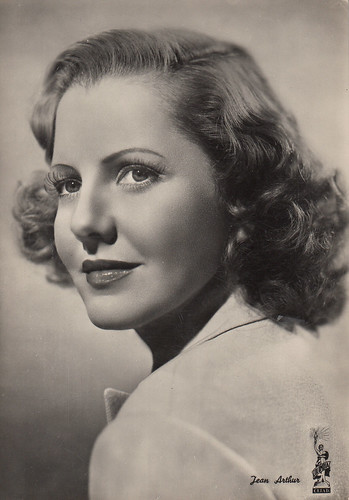
Italian postcard by Rotalfoto, Milano, no. 41. Photo: Columbia CEIAD.
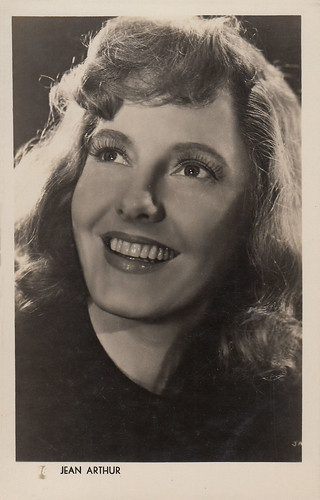
Spanish postcard by Kores Carboplan.
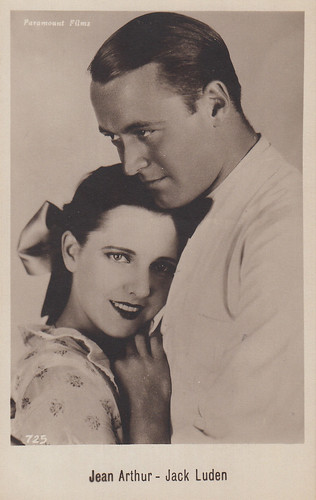
Italian postcard by G.B. Falci, Milano, no. 725. Jean Arthur and Jack Luden played together in Sins of the Fathers (Ludwig Berger, 1928).
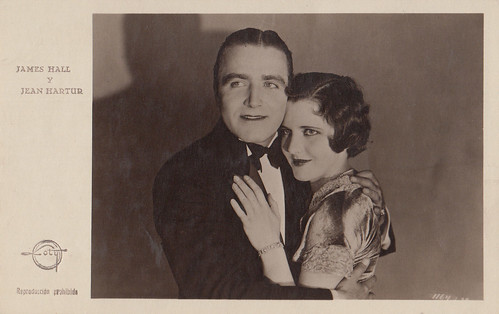
Spanish postcard by Loty, no. 1164. Jean Arthur and James Hall in The Canary Murder Case (Malcolm St. Clair, 1929).
Text and postcards: Marlene Pilaete.
No comments:
Post a Comment